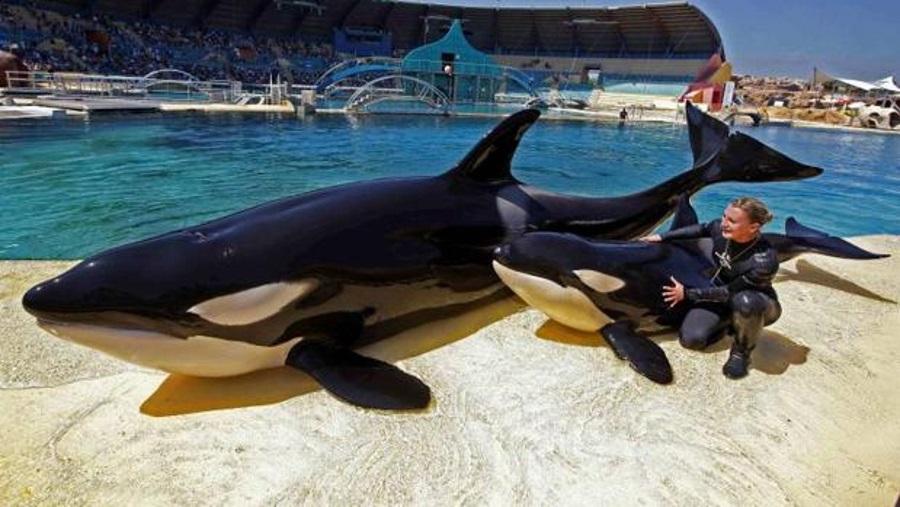A 14-year-old orca, captive-born at Marineland, Antibes, France, was trained to imitate human expressions. The killer whale could say things like hello, bye bye, count to three and repeat her trainer’s name, Amy.
One of the authors of the publication explains that even though this ability of copying sounds is wide-spread in birds, it is rare in mammals, and for the killer whale species, it is the first one.

The study made two years ago, now Wikie (the orca) is 16 years old, depicts how orcas learn to imitate the group that surrounds them, contrary to the accepted theory that claims orcas sounds are the result of social learning.
Impressive skills
To train Wikie, then researchers and her trainers taught her a signal that meant she had to copy something, then they asked her to replicate eleven sounds made by the trainer. Between these sounds, the trainer included human words, wolf howls, elephant calls and a creaking door. Surprisingly, Wikie learned to imitate most of the sounds on her first attempt.
Six judges were set to determine if the sounds made by Wikie reassembled the ones made by the trainer. The resulting review was that Wikie, in fact, made matching sounds with human words. Spectrograms and waveform analyses showed three words Wikie “said” that had a “high-quality match” with the ones said by the trainer.
The lead author of the study, comparative psychologist Jose Abramson explained:
“It means that killer whales have evolved the ability to control sound production and qualify as open-ended vocal learners as other cetaceans like belugas and bottlenose dolphins.”
Wikie, it’s now classified as an open-ended learner species, meaning that she can learn new forms of speech throughout her life since she was already an adult orca when the study began.
Forbes comments that other species like NOC, a wild-born beluga whale learned, spontaneously, to mimic human speech, even stating that:
“…human divers responded to his vocal requests to get out of his tank before they realized that it was NOC who was doing the talking.”
Different mechanisms to produce sounds, same learning method
Orca’s sound, different from human’s, is louder and sharper since humans have vocal cords in the larynx to create sounds, but the killer whales do not. The Killer Whale Organization (KWO) explains that orcas have a compact tissue in their nasal area that helps them make sounds.
Human sounds are produced thanks to the vocal cords that vibrate when pressured air comes into the vocal tract; the cords chop the airflow from the lungs creating the laryngeal sound. Pitch and tone are adjusted by the length and tension of the cords.

Their vocalizations range on a wide variety, and it is different for every pod. Although these changes are not perceptible for the human hearing system, scientists have studied their duration, frequency, and volume of those sounds, confirming the theory.
Since orcas have communities in which they grow up, just like human beings, the sounds they learn are determined by the older figures surrounding them. These leads orcas to comprehend and recognize the sounds of members of its community. According to the KWO, this is essential to identify a stick with the same group through generations.
Orcas’ ears (though not visible) are placed behind their eyes, and they are incredibly developed. They need this kind of system to survive under the sea, and under any condition, being dark or turbulent, since during this situations their sight is not enough.
Wikie doesn’t understand a word she’s saying
Although the experiment proves many theories about the killer whales and provides a whole new perspective regarding understanding the nature of their speech learning skill, a downside of the study appeared, but not disappointing the researchers yet.
While captive animals are used to people they try to imitate specific behaviors to strengthen the bond between them, explains a bioacoustician fro the University of Vienna, Angela Stoeger-Horwath. On her study about an elephant imitating human sounds, she reveals that Koshik, the elephant studied, used the sounds to bond with people, “rather for their meaning.”
So Wikie is imitating human speech with the purpose of making a more meaningful relationship between her and her trainer, while she does not understand the actual meaning of what she is saying.
This all leads to a new, more delicate way of observing and understanding these animals considering their social needs is what makes them change the things they usually do. In 2006, a team of scientists filed a report that claimed an orca was imitating a sea lion’s bark because she was solitary and was desperately trying to get attention.
Additional investigation is planned since the experiments were done above water, this implies that beneath ordinary non-captive circumstances, underwater ones, the accuracy of the reproduction of the sounds is still questionable.
Source: Forbes
